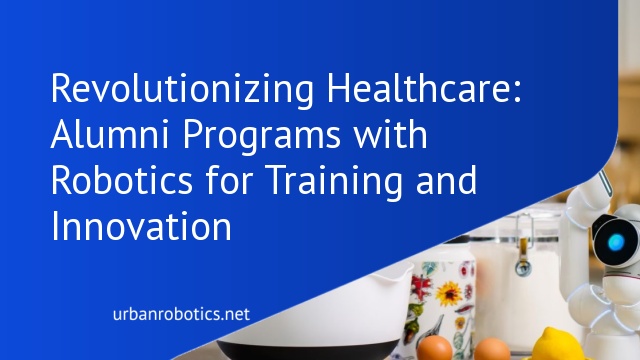Understanding Healthcare Alumni Programs
Healthcare alumni programs are pivotal in fostering ongoing professional development and collaboration among former students and colleagues.
Importance of Alumni Networks
Alumni networks provide essential connections and resources for healthcare professionals. These networks facilitate knowledge sharing, mentorship opportunities, and career advancements. They also help maintain strong ties to educational institutions. By engaging in these networks, we can stay informed about industry advancements and emerging technologies, such as robotics, which continually improve patient care and medical training.
Specific Benefits for Healthcare Industries
Healthcare industries benefit significantly from active alumni programs. These programs enable access to a pool of experienced professionals for consultations and collaborations. They also support ongoing education, ensuring that industry standards are constantly evolving. With robotics integrated into alumni programs, we can engage in hands-on training with cutting-edge technology, remaining at the forefront of medical advancements.
The Role of Robotics in Modern Healthcare
Robotics has profoundly transformed modern healthcare, enhancing precision, efficiency, and overall patient care. Advances in medical robotics have led to breakthroughs in various areas, offering significant contributions to the healthcare industry.
Innovations in Medical Robotics
Medical robotics innovations facilitate numerous advancements in healthcare. Surgical robots, for example, enable minimally invasive procedures with greater accuracy. Rehabilitation robots assist patients in recovery, offering personalized therapy sessions. Recent developments in robotic prosthetics provide improved mobility for individuals with limb loss. Additionally, diagnostic robots enhance early disease detection, improving treatment outcomes.
Impact on Patient Care and Precision
Robotics positively impacts patient care and precision by reducing human error and enhancing procedural accuracy. Robotic-assisted surgeries result in smaller incisions, leading to quicker recovery times and less postoperative pain. Automated medication dispensing systems ensure correct dosages, minimizing medication errors. In diagnostic imaging, robotic technology offers high-resolution images, allowing for more accurate diagnoses. These innovations collectively elevate the standard of patient care.
Integration of Robotics in Alumni Programs
Integrating robotics into healthcare alumni programs significantly enhances continuous learning and professional development. Alumni networks provide platforms for professionals to engage with cutting-edge technology, contributing to medical advancements.
Collaborative Research Opportunities
Robotics integration in alumni programs often leads to collaborative research opportunities. Alumni can join research initiatives focused on developing and refining robotic technologies. For example, projects on robotic-assisted surgery or automated diagnostic systems often require multidisciplinary teams. These collaborations can result in groundbreaking innovations and improvements in patient care. By participating in such research, alumni stay at the forefront of medical technology advancements, drive innovation, and contribute valuable knowledge to the healthcare field.
Technical Training and Workshops
Alumni programs incorporating robotics technology offer hands-on technical training and workshops. These sessions enable professionals to familiarize themselves with the latest robotic systems. Workshops may include practice with surgical robots, training on rehabilitation devices, or learning to operate diagnostic robotics. For instance, a workshop might involve step-by-step training on a Da Vinci surgical robot. This practical exposure ensures that alumni remain skilled in utilizing advanced technology, thereby enhancing their clinical competencies and overall patient care outcomes.
Notable Healthcare Alumni Programs with Robotics
Several healthcare alumni programs have successfully integrated robotics, enabling continuous learning and professional development.
Case Study 1: University Medical Center
The University Medical Center’s alumni program leverages robotics for advanced medical training. Alumni participate in hands-on workshops featuring robotic-assisted surgeries and automated diagnostic tools. They also join collaborative research projects to develop innovative robotic applications. The program provides alumni with the latest knowledge and practical experience, ensuring they stay ahead in the rapidly evolving healthcare landscape.
Case Study 2: Advanced Technical Institute
The Advanced Technical Institute’s healthcare alumni program focuses on integrating robotics in specialized medical fields. Participants gain access to advanced robotic systems used in minimally invasive procedures and rehabilitation therapies. Alumni receive training through interactive modules and simulation labs. Additionally, they collaborate with leading experts to explore new robotic technologies. This program ensures alumni possess cutting-edge skills for enhanced patient care.
Advantages and Challenges
Robotics in healthcare alumni programs offers significant benefits but also presents certain challenges we must address to maximize its potential.
Benefits of Robotics in Alumni Networks
Robotics enhances the skills of alumni by providing hands-on experience with innovative healthcare technologies. Medical professionals benefit from workshops and training sessions on robotic-assisted surgeries, diagnostic tools, and specialized medical fields. These experiences improve patient care and keep professionals current with advancements. Alumni networks facilitate collaborative research projects, leading to new healthcare solutions and improved industry standards.
Potential Challenges and Solutions
Integrating robotics in alumni programs can be expensive and complex. However, institutions can leverage partnerships with tech companies and secure grants to offset costs. Accessibility might be another issue, but offering online workshops and virtual simulations ensures broader participation. Technical proficiency varies among alumni, so ongoing education and support are essential to enable all members to benefit from robotics. These strategies help overcome the primary obstacles faced in implementing robotics in alumni programs.
Conclusion
Healthcare alumni programs leveraging robotics are transforming the landscape of medical education and patient care. By integrating cutting-edge technology, these programs ensure that healthcare professionals remain at the forefront of innovation. Alumni gain invaluable experience through workshops, research projects, and hands-on training with advanced robotic tools.
Despite challenges like cost and accessibility, the benefits of improved skills and enhanced collaboration are undeniable. Institutions can overcome these hurdles through strategic partnerships, grants, and continuous education. As we move forward, embracing robotics in alumni programs will be crucial for advancing industry standards and improving patient outcomes.





